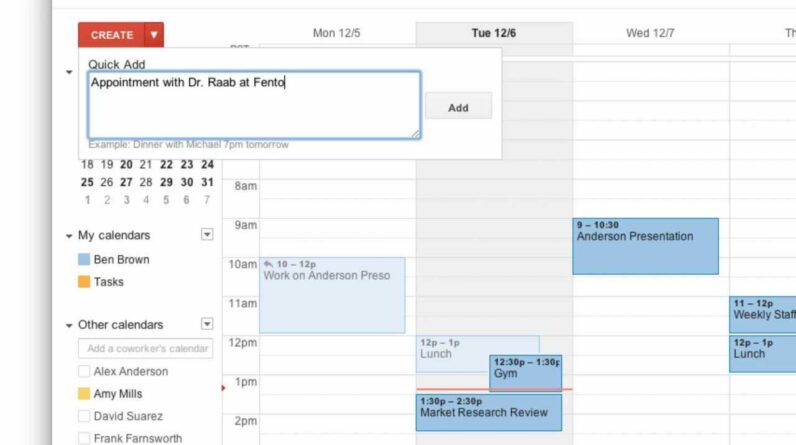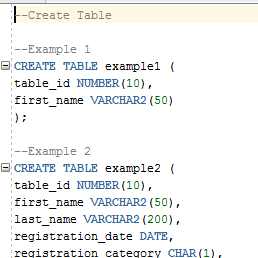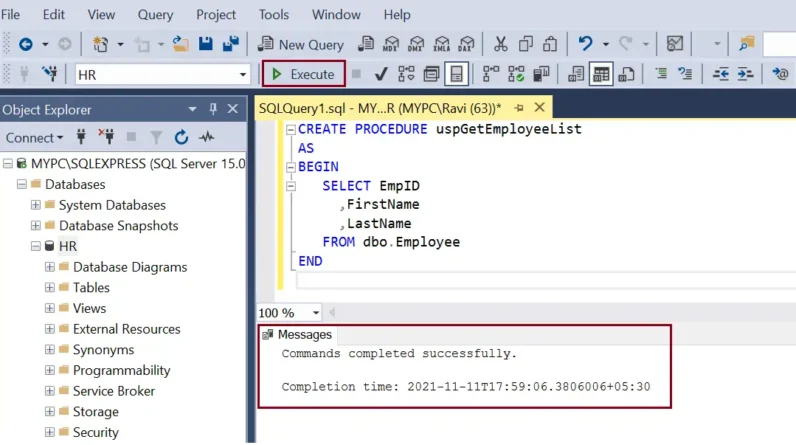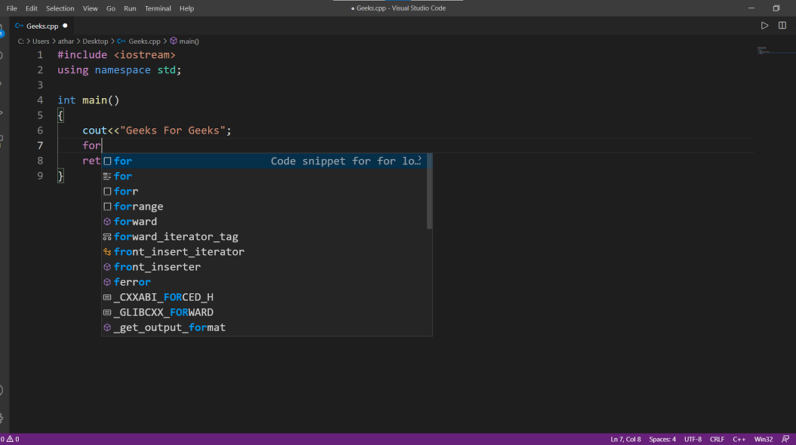
In this article, we’ll explore the topic of creating custom snippets in VS Code. By the end, you’ll understand how to personalize and optimize your coding experience by creating your own snippets. We’ll cover the steps and techniques required to create these snippets, allowing you to save time and write code more efficiently. So let’s get started and discover how to master VS Code with custom snippets.
Table of Contents
Mastering VS Code: Creating Custom Snippets
Introduction to VS Code
In the world of coding and development, efficient and streamlined workflows are essential for productivity. Visual Studio Code, commonly known as VS Code, has gained immense popularity among developers for its versatility and ease of use. With its wide range of features, including the ability to create custom snippets, VS Code provides developers with the tools they need to enhance their coding experience. In this article, we will explore the benefits of using VS Code, delve into the concept of snippets, and learn how to create and manage custom snippets in order to personalize your coding environment and boost productivity.
Benefits of using VS Code
Before we dive into the intricacies of custom snippets, let’s take a moment to understand why using VS Code can greatly benefit developers. First and foremost, VS Code is an open-source text editor developed by Microsoft, making it freely available for all programmers. Its cross-platform compatibility ensures that developers can seamlessly transition between different operating systems without compromising on functionality.
Moreover, one of the key advantages of VS Code is its extensive marketplace of extensions. These extensions allow users to customize their editor to suit their specific needs and coding preferences. By leveraging the power of extensions, developers can enhance their productivity and streamline their coding workflow. Custom snippets, in particular, are a powerful feature that enables developers to insert commonly used code snippets with just a few keystrokes, saving valuable time and reducing the chances of errors.
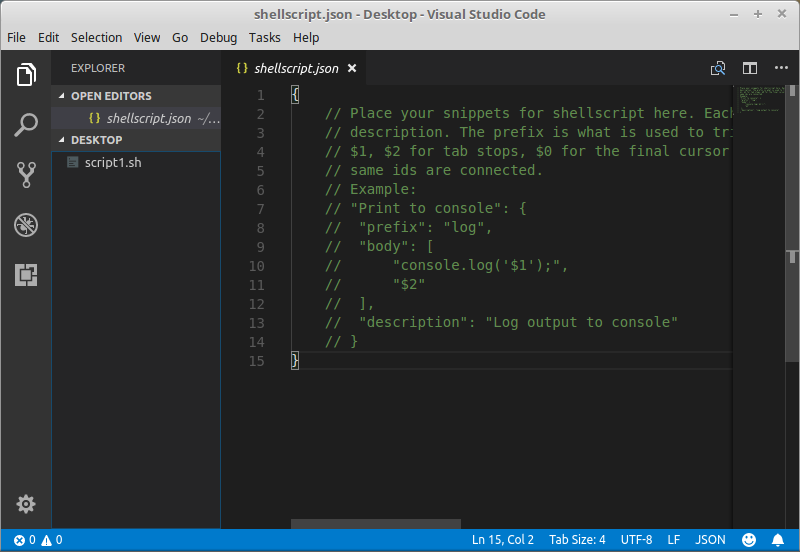
Understanding Snippets
What are snippets?
In VS Code, snippets are fragments of reusable code that can be quickly inserted into your files. They are designed to simplify repetitive coding tasks and speed up your development process. Snippets can include anything from a single line of code to large blocks of code, and they can be triggered by typing a predefined abbreviation or keyword. By leveraging snippets, you can avoid typing redundant code and focus on the core logic of your project.
Why use snippets in VS Code?
Using snippets in VS Code has numerous benefits. Firstly, as mentioned earlier, snippets allow you to quickly insert commonly used code snippets, which saves you time and effort. By defining your own snippets, you can create a personal library of code patterns tailored to your specific coding style and preferences. This not only enhances your productivity but also ensures consistency across your projects.
Snippets also promote code readability and reduce errors. By using well-defined snippets, you can ensure that all code follows a standardized format and adheres to best practices. This can be particularly useful when working collaboratively, as it reduces the learning curve for team members and makes the codebase more maintainable.
Creating Custom Snippets
Now that we have a good understanding of snippets and their benefits, let’s explore how to create custom snippets in VS Code.
Installing the necessary extensions
Firstly, ensure that you have the necessary extensions installed for creating and managing snippets. To do this, open the Extensions view in VS Code by clicking on the square-shaped icon on the left sidebar or by pressing Ctrl+Shift+X on Windows or Cmd+Shift+X on macOS. Search for “snippet” in the extensions marketplace and look for extensions such as “Snippet Generator” or “Snippet Creator”. Install the extension that best suits your needs.
Accessing the Snippets Editor
Once you have the required extension installed, access the Snippets Editor by navigating to the Preferences menu in VS Code. From there, select the User Snippets option. This will open a dropdown menu where you can choose the programming language for which you want to create a snippet. In this menu, you will find a list of predefined snippets for the selected language, as well as an option to create a new snippet.
Defining a new snippet
To create a new snippet, select the language for which you want to define the snippet and choose the New Global Snippets file option. This will open a new file in which you can define your custom snippet.
A snippet consists of a prefix, which is the keyword or abbreviation that triggers the insertion of the snippet, and the body, which is the actual code that will be inserted. For example, let’s say we want to create a custom snippet for adding a basic HTML template. We can define the following snippet:
"HTML Template": { "prefix": "html", "body": [ "", "", "", " Hello, World! ", "", "", " Hello, World!
", "", "" ], "description": "Inserts a basic HTML template" } In this example, the prefix is set to “html”, so whenever we type “html” followed by a trigger key (usually Tab), the entire HTML template will be inserted at the cursor position.
Snippet syntax and variables
When defining a snippet, you can also leverage the power of snippet syntax and variables to make your snippets more dynamic and flexible. Snippets support variables such as $1, $2, etc., which act as placeholder values that can be easily navigated through using the Tab key. You can also use transform functions such as $ to dynamically generate values based on the current file’s name.
For example, let’s say we want to create a snippet for a basic JavaScript function that takes in two parameters. We can define the following snippet:
"JavaScript Function": { "prefix": "func", "body": [ "function $1($2) {", " // Code goes here", "}" ], "description": "Inserts a basic JavaScript function" } In this example, $1 acts as a placeholder for the function name, and $2 serves as a placeholder for the function parameters. When the snippet is inserted, you can easily navigate through these placeholders using the Tab key and replace them with the desired values.
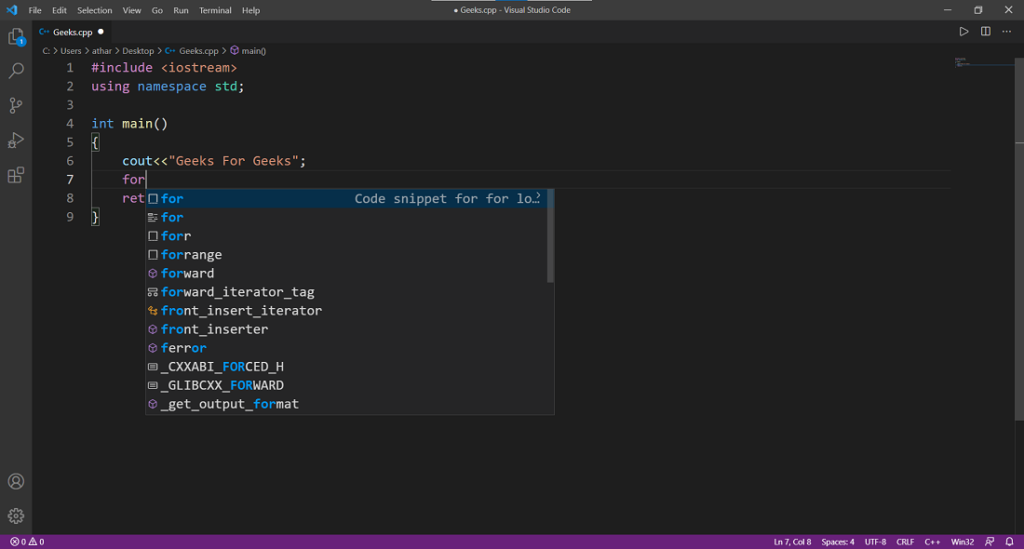
Advanced Snippet Techniques
Creating basic snippets is just the tip of the iceberg when it comes to harnessing the full potential of snippets in VS Code. Let’s explore some advanced techniques that can take your snippet game to the next level.
Using tab stops and placeholder values
Tab stops and placeholder values allow you to define areas within your snippet that can be easily modified after insertion. By defining tab stops using $1, $2, etc., you can navigate through these areas using the Tab key and quickly provide the necessary values. This is particularly useful when creating snippets for code structures that require user-specific inputs.
For example, let’s say we want to create a snippet for a CSS class declaration that requires a class name and a set of properties. We can define the following snippet:
"CSS Class Declaration": { "prefix": "class", "body": [ ".$ {", " $2", "}" ], "description": "Inserts a CSS class declaration" } In this example, $1 defines a tab stop for the class name, and $2 defines a tab stop for the CSS properties. The default value for the class name is set to “className” using $, which can be quickly modified after insertion.
Adding multiple cursor support
VS Code allows you to add multiple cursors to the same snippet insertion point, enabling you to quickly fill in repetitive values across multiple lines. By adding a Tab character to your snippet body, you can define the positions where you want the cursors to be added.
For example, let’s say we want to create a snippet for creating an HTML list. We can define the following snippet:
"HTML List": { "prefix": "list", "body": [ "", " - $
", " - $
", " - $
", "
" ], "description": "Inserts an HTML list" } In this example, each list item has a separate cursor position defined using $, $, $. After the snippet is inserted, pressing Tab will move the cursor to the next defined position, allowing you to quickly fill in multiple list items.
Defining keybindings for snippets
While snippets can be triggered using their predefined prefixes, you can also assign keybindings to your custom snippets for faster access. Keybindings allow you to trigger the snippet using a specific key combination, eliminating the need to type the prefix.
To define a keybinding for a snippet, open the keybindings.json file in VS Code by selecting Preferences > Keyboard Shortcuts. In this file, you can define custom keybindings by associating certain keys or key combinations with your desired snippets.
Managing Snippets
Now that we have learned how to create custom snippets, let’s explore some best practices for managing and organizing your snippets.
Organizing snippets into folders
As the number of custom snippets grows, it becomes increasingly important to organize them into logical folders for easy retrieval. By grouping related snippets together, you can quickly locate the desired snippet when you need it.
To organize snippets into folders, create a new folder in your snippets directory and place the corresponding snippet files inside it. The snippets editor in VS Code will automatically detect and display the snippets in their respective folders for easy access.
Sharing snippets with others
Sharing snippets with other developers is a great way to contribute to the coding community and promote collaboration. VS Code allows you to share your snippets by exporting them in JSON format, which can then be imported by other users.
To export your snippets, navigate to the Preferences > User Snippets menu and select the programming language for which you want to export the snippets. From the dropdown menu, choose the Export Snippets option and save the JSON file to your desired location. Other developers can then import this JSON file using the Preferences > User Snippets > Import Snippets option to start using your shared snippets.
Importing and exporting snippets
Importing snippets can be extremely useful when you are working on multiple machines or collaborating with other developers. By importing snippets, you can easily replicate your customized snippet library across different environments.
To import snippets, navigate to the Preferences > User Snippets menu and select the programming language for which you want to import the snippets. From the dropdown menu, choose the Import Snippets option and select the JSON file containing the snippets you want to import.

Using Snippet Libraries
While creating your own snippets is a powerful way to personalize your coding environment, leveraging existing snippet libraries can be a game-changer in terms of productivity. VS Code offers a vast marketplace of snippet extensions that provide pre-defined snippets for various programming languages, frameworks, and libraries.
Exploring popular snippet libraries
When it comes to snippet libraries, there are numerous options available, each catering to different programming languages and frameworks. Some popular snippet libraries include:
- ES7 React/Redux/GraphQL/React-Native snippets: This library provides a comprehensive set of snippets for developing web applications using React, Redux, GraphQL, and React Native.
- Bootstrap 4 & Font Awesome snippets: This library includes snippets for Bootstrap 4 and Font Awesome, making it easier to quickly create responsive web pages with modern styling.
- Python Snippets: This library offers a wide range of snippets for Python, covering common programming constructs and libraries.
By exploring these libraries and finding the ones that align with your preferred languages and frameworks, you can greatly enhance your coding experience and speed up development.
Installing and configuring snippet libraries
To install a snippet library, open the Extensions view in VS Code, search for the desired library, and follow the installation instructions. Once the library is installed, you can start benefiting from the pre-defined snippets provided by the library.
To further enhance your experience with snippet libraries, you can customize and configure them according to your needs. Snippet extensions often provide configuration options that allow you to toggle certain snippets, customize the trigger keywords, or even define your own custom snippets using the library’s base snippets as a starting point.
Debugging Snippets
While creating and using snippets can significantly boost your productivity, it’s essential to ensure that your snippets are error-free and functioning as expected. Debugging snippets helps identify and fix any issues that might arise during their usage.
Identifying and fixing snippet errors
VS Code provides a dedicated Snippets Debugger to help you identify and address errors in your custom snippets. To access the Snippets Debugger, open the Command Palette (Ctrl+Shift+P / Cmd+Shift+P) and search for “Snippets: Show Snippet Log”. This will open a separate Log Output panel where you can view any errors or warnings reported by the snippets.
If you encounter any errors, carefully review the affected snippet and make the necessary corrections. Common errors include syntax mistakes, missing quotation marks, or improper values assigned to variables. By fixing these errors, you can ensure that your snippets work seamlessly and function as intended.
Testing and validating snippets
Before using your custom snippets in a production environment, it’s crucial to thoroughly test and validate them to avoid any unexpected behavior. To test your snippets, create a new file in the language for which the snippet is defined and try inserting the snippet using its prefix. Ensure that the snippet is inserted correctly and that any tab stops or placeholder values function as expected.
Additionally, consider testing your snippets in different scenarios and edge cases to uncover any potential issues. This includes testing them with different input values, in different file types, and in combination with other snippets or code structures.
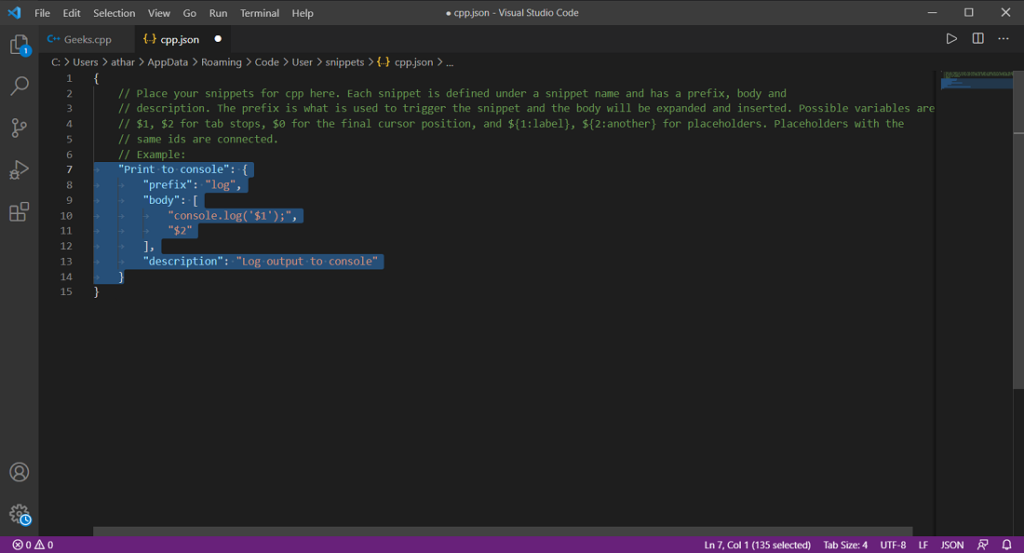
Best Practices for Snippet Creation
While it’s relatively easy to create snippets, it’s important to follow some best practices to ensure that your snippets are effective and maintainable.
Writing clear and concise snippets
When creating snippets, strive for clarity and simplicity. Keep your snippets short and avoid including unnecessary code or excessive comments. The goal is to provide a ready-to-use code fragment that is concise and easy to understand.
Consider adding a brief description for each snippet to provide context and explain its purpose. This description will be displayed when browsing or searching for snippets, making it easier for you and others to quickly identify the desired snippet.
Avoiding common pitfalls
When defining snippets, you might encounter common pitfalls that can affect their functionality or clarity. Be aware of these pitfalls and take steps to avoid them:
- Syntax errors: Make sure your snippet follows the correct syntax for the programming language. Incorrect syntax can prevent the snippet from being inserted or produce unexpected results.
- Ambiguous prefixes: Avoid using prefixes that are too generic or similar to existing keywords. This can lead to conflicts or unintentional triggers, making it harder to use the desired snippet.
- Overlapping placeholders: Ensure that the positions of your placeholders do not overlap. Overlapping placeholders can cause confusion and lead to unintended behavior during snippet insertion.
By being mindful of these pitfalls and conducting thorough testing, you can create high-quality snippets that are error-free and reliable.
Regularly updating and maintaining snippets
As your coding projects evolve and new technologies emerge, it’s essential to regularly update and maintain your snippets. Review your snippets periodically to ensure that they are up to date with the latest coding standards and best practices. This includes updating deprecated code snippets and incorporating new features or patterns that you frequently use.
Additionally, consider sharing your updated snippets with the community. By contributing your improved snippets, you can help other developers and foster collaboration within the coding community.
Personalizing VS Code with Custom Snippets
Custom snippets are a powerful tool that allows you to personalize your coding environment and tailor it to your specific needs. Let’s explore some ways you can use custom snippets to enhance your coding experience.
Creating custom snippets for specific programming languages
Custom snippets can be created for any programming language or framework supported by VS Code. Whether you are working with JavaScript, Python, CSS, or any other language, you can define snippets that align with your coding style and commonly used code patterns.
By creating custom snippets that cater to your preferred programming languages, you can significantly reduce the amount of repetitive typing and improve the overall efficiency of your workflow.
Tailoring snippets to match your coding style
Custom snippets allow you to define coding patterns that reflect your preferred coding style. Whether you have specific indentation preferences, naming conventions, or code organization practices, you can incorporate them into your custom snippets.
By tailoring your snippets to match your coding style, you can ensure consistency across your projects and promote readability within your codebase. This is especially useful when working in teams, as it helps maintain a unified code style and reduces the cognitive load for teammates.
Enhancing productivity with well-crafted snippets
Ultimately, the goal of custom snippets is to enhance your productivity and make your coding experience more efficient. By creating well-crafted snippets that cover common coding scenarios and repetitive tasks, you can significantly reduce the time and effort required for development.
Consider analyzing your coding patterns and identifying areas where you spend a significant amount of time on repetitive tasks or commonly use code snippets. By creating custom snippets that address these areas, you can streamline your workflow and allocate more time to solving complex problems or exploring new ideas.
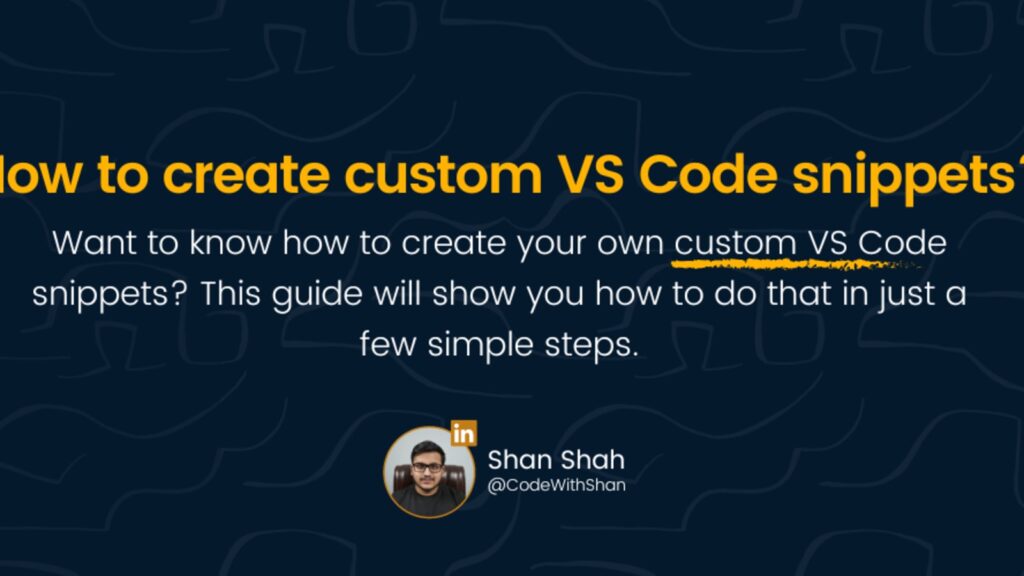
Conclusion
In this article, we explored the power of custom snippets in VS Code and learned how to create, manage, and debug snippets. We discussed the benefits of using VS Code for coding, dove into the concept of snippets, and explored advanced techniques for creating dynamic and flexible snippets. We also learned how to organize and share snippets, leverage existing snippet libraries, and enhance our productivity with well-crafted snippets.
By mastering the art of creating custom snippets in VS Code, you can personalize your coding environment, optimize your workflow, and boost your productivity as a developer. So go ahead, unleash the power of custom snippets, and take your coding to the next level!



